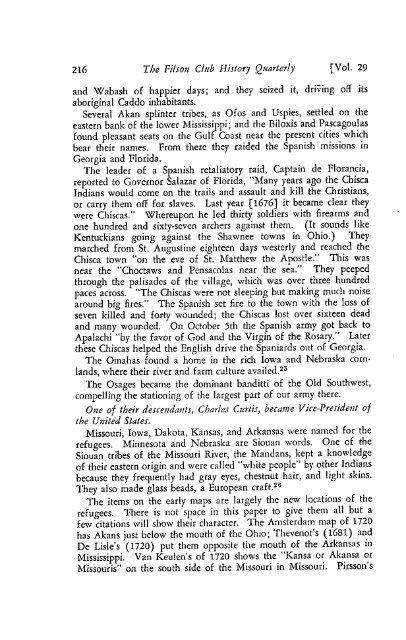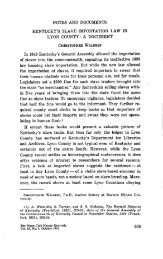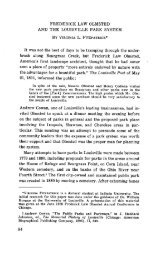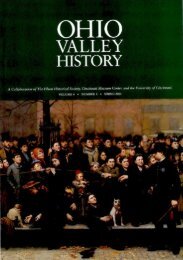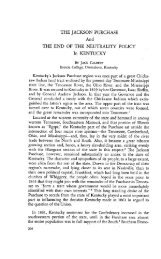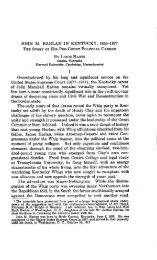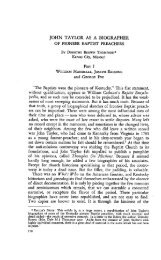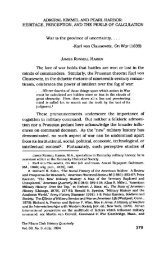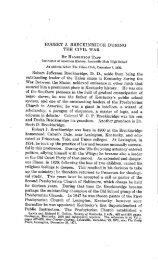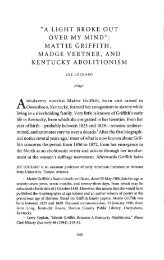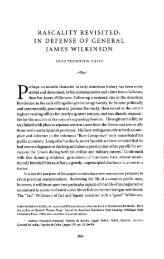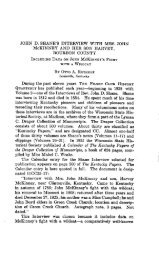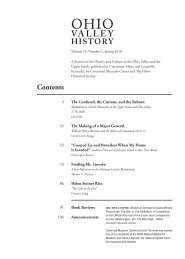the filson club history quarterly - The Filson Historical Society
the filson club history quarterly - The Filson Historical Society
the filson club history quarterly - The Filson Historical Society
You also want an ePaper? Increase the reach of your titles
YUMPU automatically turns print PDFs into web optimized ePapers that Google loves.
216 <strong>The</strong> <strong>Filson</strong> Club History Quarterly [Vol. 29<br />
and Wabash of happier days; and <strong>the</strong>y seized it, drireing off its<br />
aboriginal Caddo inhabitants.<br />
Several Akan splinter tribes, as Ofos and Uspies, settled on <strong>the</strong><br />
eastern bank of <strong>the</strong> lower Mississippi; and <strong>the</strong> Biloxis and Pascagoulas<br />
found pleasant seats on <strong>the</strong> Gulf Coast near <strong>the</strong> present cities which<br />
bear <strong>the</strong>ir names. From <strong>the</strong>re <strong>the</strong>y raided <strong>the</strong> Spanish missions in<br />
Georgia and Florida.<br />
<strong>The</strong> leader of a Spanish retaliatory raid, Captain de Florancia,<br />
reported to Governor Salazar of Florida, "Many years ago <strong>the</strong> Chisca<br />
Indians would come on <strong>the</strong> trails and assault and kill <strong>the</strong> Christians,<br />
or carry <strong>the</strong>m off for slaves. Last year [16761 it became clear <strong>the</strong>y<br />
were Chiscas." Whereupon he led thirty soldiers with firearms and<br />
one hundred and sixty-seven archers against <strong>the</strong>m. (It sounds like<br />
Kentuckians going against <strong>the</strong> Shawnee towns in Ohio.) <strong>The</strong>y<br />
marched from St. Augustine eighteen days westerly and reached <strong>the</strong><br />
Chisca town "on <strong>the</strong> eve of St. Mat<strong>the</strong>w <strong>the</strong> Apostle." This was<br />
near <strong>the</strong> "Choctaws and Pensacolas near <strong>the</strong> sea." <strong>The</strong>y peeped<br />
through <strong>the</strong> palisades of <strong>the</strong> village, which was over three hundred<br />
paces across. "<strong>The</strong> Chiscas were not sleeping but making much noise<br />
around big fires." <strong>The</strong> Spanish set fire to <strong>the</strong> town with <strong>the</strong> loss of<br />
seven killed and forty wounded; <strong>the</strong> Chiscas lost over sixteen dead<br />
and many wounded. On October 5th <strong>the</strong> Spanish army got back to<br />
Apalachi "by <strong>the</strong> favor of God and <strong>the</strong> Virgin of <strong>the</strong> Rosary." Later<br />
<strong>the</strong>se Chiscas helped <strong>the</strong> English drive <strong>the</strong> Spaniards out of Georgia.<br />
<strong>The</strong> Omahas found a home in <strong>the</strong> rich Iowa and Nebraska cornlands,<br />
where <strong>the</strong>ir river and farm culture availed. =a<br />
<strong>The</strong> Osages became <strong>the</strong> dominant banditti of <strong>the</strong> Old Southwest,<br />
compelling <strong>the</strong> stationing of <strong>the</strong> largest part of our army <strong>the</strong>re.<br />
One of <strong>the</strong>ir descendants, Charles Curtis, became Vice-President o/<br />
<strong>the</strong> United States.<br />
Missouri, Iowa, Dakota, Kansas, and Arkansas were named for <strong>the</strong><br />
refugees. Minnesota and Nebraska are Siouan words. One of <strong>the</strong><br />
Siouan tribes of <strong>the</strong> Missouri River, <strong>the</strong> Mandans, kept a knowledge<br />
of <strong>the</strong>ir eastern origin and were called "white people" by o<strong>the</strong>r Indians<br />
because <strong>the</strong>y frequently had gray eyes, chestnut hair, and light skins.<br />
<strong>The</strong>y also made glass beads, a European craft. 26<br />
<strong>The</strong> items on <strong>the</strong> early maps are largely <strong>the</strong> new locations of <strong>the</strong><br />
refugees. <strong>The</strong>re is not space in this paper to give <strong>the</strong>m all but a<br />
few citations will show <strong>the</strong>ir character. <strong>The</strong> Amsterdam map of 1720<br />
has Akans just below <strong>the</strong> mouth of <strong>the</strong> Ohio; <strong>The</strong>venot's (1681) and<br />
De Lisle's (1720) put <strong>the</strong>m opposite <strong>the</strong> mouth of <strong>the</strong> Arkansas in<br />
Mississippi. Van Keulen's of 1720 shows <strong>the</strong> "Kansa or Akansa or<br />
Missouris" on <strong>the</strong> south side of <strong>the</strong> Missouri in Missouri. Pirsson's


